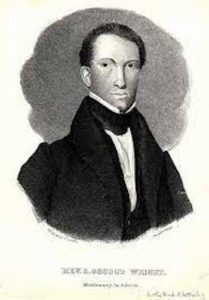
Robert Benjamin Lewis
*The birth of Robert Benjamin Lewis is celebrated on this date in 1802. He was an African and Native American author, ethnologist, and inventor.
He was born in the portion of Pittston, Maine, which later became the city of Gardiner. He was the eldest son of Matthias Lewis and Lucy (Stockbridge) Lewis. Matthias Lewis was either a Mohegan from southern Rhode Island or a Pequot from New London and Montville, Connecticut. On October 26, 1806, a 27-year-old sailor named Mathias Lewis from Kennebec County, Maine, appeared at the United States Customs House in New London, Connecticut, and received a Seamen's Protection Certificate or protection papers.
Lucy Stockbridge was the daughter of one Isaac Hazard Stockbridge, an African kidnapped as a child and purchased by Dr. Silvester Gardiner of Boston, a wealthy physician, pharmaceutical manufacturer, and land developer of Maine. Lucy, born in 1769, was the daughter of Hazard by his wife, Cooper Loring.
After some years in school, young Lewis appears to have gone to sea. His daughter stated Lewis served as a cabin boy in the War of 1812. However, he wanted to become a missionary to Africa and preach the Gospel to the indigenous people. Lewis was never licensed as a preacher or ordained as a minister; however, he brought from his studies a thorough knowledge of the Bible and classical history.
Lewis was married twice: first to Mrs. Wealthia Ann Jones in New York City in late 1828, and secondly, to eighteen-year-old Mary Freeman Huston, the fourth of nine children of an escaped slave at the Charles Street Baptist Church in Boston, on March 17, 1835. Lewis had three sons and seven daughters from his second marriage. Lewis made his living by engaging in a variety of odd jobs. He was a sailor, ship's cook, steward, whitewasher, and day laborer at various times.
He held three United States patents, making him one of the few nineteenth-century black inventors who could patent their inventions or improvements to existing manufacturing processes. In his application for a United States Patent dated April 11, 1836, Lewis stated, "I, Robert Benjamin Lewis of Hallowell, in the county of Kennebec, and the state of Maine, have invented a new and the useful machine for the picking of oakum and hair." The patent was awarded on June 25, 1836. The "hair picker" became a mainstay of Maine shipyards, the original design being reworked and refined over the years.
On June 27, 1840, Lewis received U.S. Patent No. 1655 from New York City businessman John H. Stevens. This patent was for a "Feather Renovator," or a "Machine for Cleaning and Drying Feathers," described as the "arrangement and combination of feathers by steam and steam heat" and could be used for "dressing over old feathers or preparing new feathers for any domestic purposes."
When Lewis worked as a whitewasher, on February 23, 1841, he issued U.S. Patent no. 1992 for his improvement on large brushes used for whitewashing and "Such other Purposes to which the Same may be applicable." "The object of my improvements is to remedy these defects effectually and to provide, as it were, a framework in which new bristles may be inserted at a trifling expense after the old ones become unfit to use." He also successfully developed and marketed a concoction called "Lewis' Arabian Hair Oil." He sold his hair oil for many years.
In 1836, Robert B. Lewis published a 176-page book entitled Light and Truth—the first "history book" about African Americans and Native Americans. The book was published in Portland, Maine, and printed by local bookseller and printer Daniel Clement Colesworthy. At the end of the book, Lewis noted that he hadn't said all that he wanted to and stated. He continued to collect more information, and in 1843 he decided to issue an expanded version of Light and Truth totaling four hundred pages. In November 1843, four black businessmen of Boston—clothier Thomas Dalton, shoemaker and old clothes dealer James Scott, junk dealer Andress V. Lewis (no relation), and shoemaker Charles H. Roberts purchased the copyright of the expanded version of Light and Truth and by March of the next year produced it in one volume.
The printer was Charles Roberts' half-brother Benjamin F. Roberts. The book itself would go through two more printings. Light and Truth can be found in many libraries—the 1844 edition produced by the Committee of Colored Gentlemen has been reprinted in two twentieth-century versions—in 1970 by Kraus Reprint and most recently by Black Classic Press. As an ethnologist, his book Light and Truth was black ethnology that denounced notions of white superiority. During Lewis's life, the American school of ethnology held that non-white races were inherently inferior. It argued that God created the inferior races at a different time than Caucasians. In Light and Truth, Lewis exposed the illegitimacy of these views and asserted that all of humankind has a common origin.
Both an African American and Native American himself, Lewis also emphasized a shared cultural and reproductive history between African and Native Americans. After living for almost twenty years in Hallowell, Robert Benjamin Lewis moved his family to Bath, Maine, in about 1848, where he built a cottage near the Sagadahoc County courthouse on Lincoln Street. Lewis signed on as a ship's cook and steward on the merchantman Philip Larrabee of Bath, bound for the Haitian capital of Port-au-Prince in early 1858. Upon the ship's arrival, Lewis fell ill, and sometime during February 1858, he died and was buried in Haiti.
